Previous Article
Next Article
- AM WORLD
- FEATURES
CULTURE
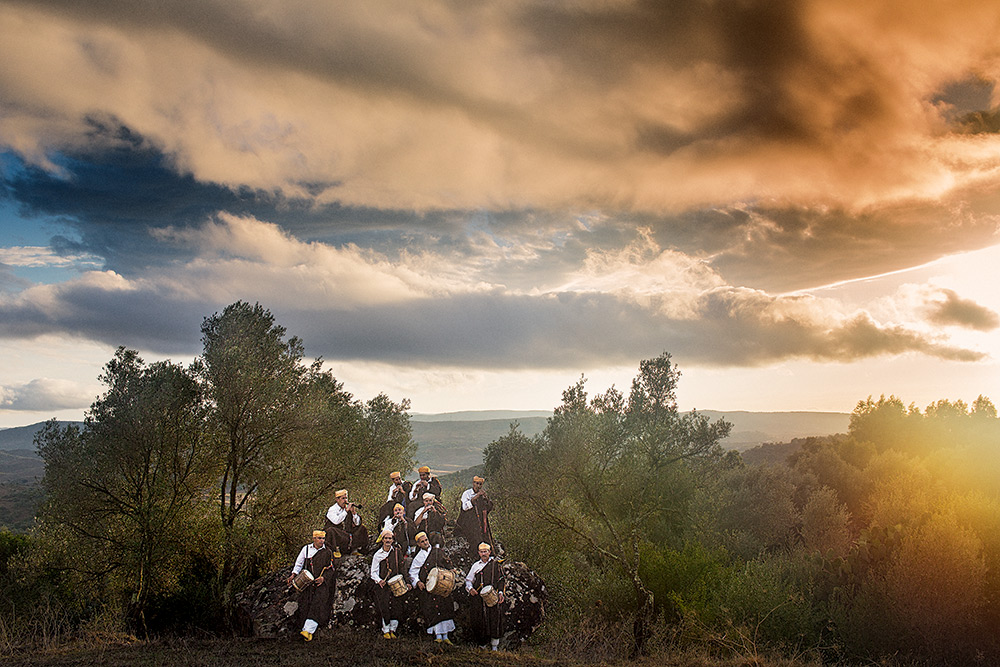
The Master Musicians of Jajouka on the outskirts of their village in the Rif mountains.
DISTANT DRUMS
Paul Trynka travels to the source of blues music,
an inspiration for the likes of the Rolling Stones and
The Who, in the atmospheric mountains of Morocco
Photographs: Sam Faulkner
THE HUBBUB AROUND the Jemaa el-Fnaa, an ancient open space in Marrakech, packed with street vendors, snake charmers, performing monkeys, musicians, magicians and craftsmen, is phenomenal—the shouts of salesmen touting barbecued fish, poached seasnails or leather slippers, the buzz of motor scooters, amplified calls to prayer and jangling of brassware—and throughout it all, the beat of the drums. This corner of the Moroccan city is thrillingly confusing, exotic, and occasionally a little scary. But it’s somehow familiar, too. It reminds me of Chicago’s West Side, the hills of Marshall County near Memphis, and most of all of a little village called Bentonia, in Yazoo County, Mississippi. The beat is foreign, but somehow familiar—to all of us.
In later years, I learned more about the source of the blues, how the first primitive instruments—one-string guitars made from cigar boxes—derived from African originals, as did many of the early, lost song forms. Different strands of the music emerged from various parts of Africa. Yet the influence of Morocco keeps recurring, particularly from two distinct groups—the Berber and Gnawa, near Marrakech—and the music of Jajouka, a village in the Ahl Srif mountains. My trip takes me first to Tangiers, where I had first heard Berber music by Rouicha Mohamed, spilling out of one of the simple stuccoed houses in the Medina, an area that’s still medieval in feel. This part of town has changed little in the past few decades; without thinking, I stop for a coffee in the most inviting bar that looks out on a tiny square.
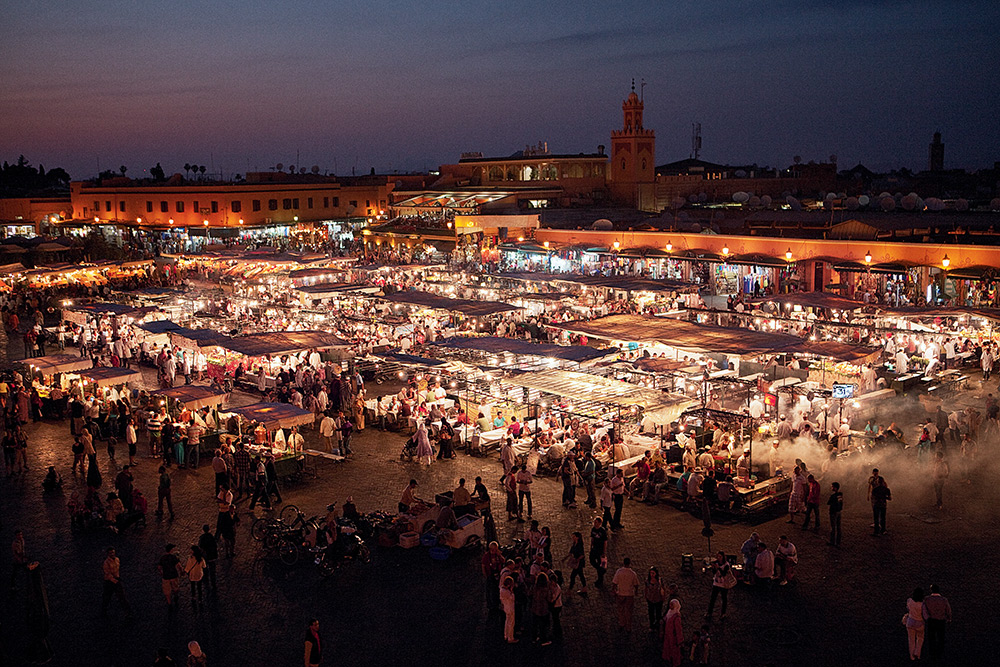
The bustling Jemaa el-Fnaa square in the centre of Marrakech is a thrilling sea of noise, colour and humanity.
It’s late, around 11pm, but they can still rustle up a perfect Moroccan salad with fragrant tomatoes and cucumber. After a few minutes acclimatising, I realise I’ve intuitively chosen the Café Central, a regular haunt for the writer William Burroughs and the artist and poet Brion Gysin, two of the city’s most famous residents. Just opposite is the Hotel Fuente, where Gysin stayed for years. The city abounds in similarly resonant locations, but after just one night I’m headed for Marrakech. The sleeper out of Tangiers is one of the world’s great train journeys—like all great rides, it takes you outside your comfort zone. “Une couchette? Vraiment?” say the counter staff incredulously, as if you’re asking for a ticket for a ride to the moon. Yet the train is clean and safe, its leatherette sleeper cabins reminiscent of a 1960s Bond movie. I travel with a couple of students, Thomas and Sofian (one Dutch, one Moroccan), discussing music, politics and, most importantly, food until the early hours. The conversation is punctuated by silences as we take in the stark, dark beauty of the desert rushing by. The night is a deep inky black; huge cacti seem to store the light for half an hour or so after sunset, and emit a ghostly glow, while lonely palms stand sentinel in the desert.
It’s a stark awakening at 8am. Compared to Tangiers, Marrakech is a shock—different colours, different light. The city is all terracottas, low-rise buildings dominated by the majestic Koutoubia minaret. In the wide open spaces, there’s little respite from the glaring orange sun. On my first day, I sip orange juice and coffees at the famed
Es Saadi resort. It’s a huge, walled luxury complex, with an anonymous hotel surrounded by fantasy chalets and an opulent swimming pool, where Cecil Beaton once ogled Mick Jagger. The luxury and the shade offered by the generous palms and well-watered oleander is tempting, but instead I head for the heart of the Jemaa el-Fnaa, the huge square opposite the Koutoubia mosque, that has hosted hucksters and musicians for most of the
past millennium.
Street vendors sell sardines, baby sausages, grilled aubergine, or sit over handcrafted goods made from leather, wool, or shiny nondescript metal; when they manage to entice a passing customer, they sing in spontaneous excitement, shooting superior looks to their nearby rivals. In some ways the hassling and huckstering are identical to every other market throughout the world. Yet it’s also unique; there is nothing battery-powered, hardly anything made of plastic.
For two nights running, I’m drawn to the stalls where white-coated vendors oversee huge
piles of sea snails, stacked up in a deep red-brown broth. Served in a well-worn white bowl, the broth goes on forever—I’d sip it all night but the music
is calling.
Marrakech is known for its Berber and Gnawa music and I’m hoping to see one Gnawan mainstay, Hassan l’Gaderi. I ask around, in my schoolboy French, and meet an old Hassan, a young Hassan, a friend of Hassan, all with something to sell. I find out later that he’s probably in the coastal city of Essaouira for an upcoming festival. Like many experiences in Morocco, the diversion is just as entertaining as the planned route, for as the sun goes down, I find myself drawn to another Hassan, Hassan Khontjja, who plays Amazigh—a more southern Berber music—involving massed percussion, the rebab, a one-string violin, and four-string banjo, a modernised version of the ancient gimbri.
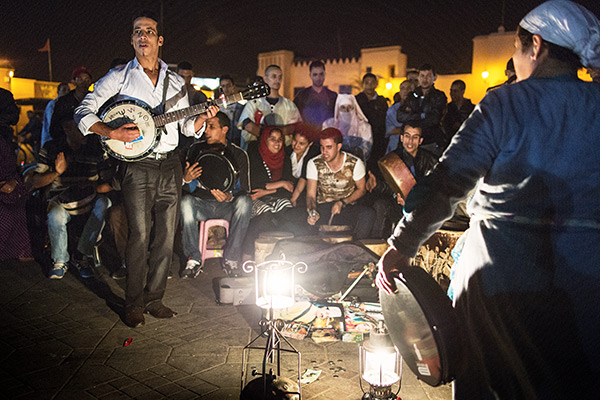
One of the many street musicians who populate the square to entertain visitors
Time becomes unreal; I spend hours that feel like minutes, listening as the drums boom, and the musicians spool out jagged, often bluesy riffs from the rebabs as Hassan directs both crowd and music. I love Hassan; that combination of well-worn music, honed over decades of playing, and his huckster showmanship; if the money in the kitty is insufficient, he’ll harangue the crowd, cheerily, for 10 or 15 minutes before they hand over enough dirham. The music increases in intensity from 10 in the evening, and as the hypnotic call and response chants stretch on, the crowd builds in size to a hundred or more. As older women with children arrive, they are ushered to little benches or upturned buckets near the front, which are also reserved for the high rollers like me, who proffer 20 dirham notes. Music, in Morocco, comes in a lot cheaper than taxi fares.
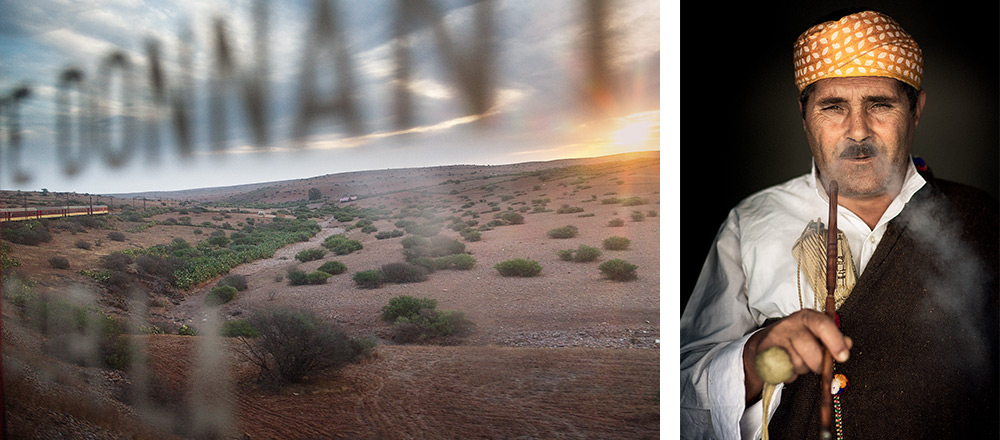
Left: a dawn view from the train heading out of Tangiers and into the Moroccan countryside. Right: a Jajouka musician in his formal, almost military-like robes
As the shadows lengthen over the square, Hassan lights up a little gas lamp, which shows the musicians’ craggy faces in sharp relief, and sends giant shadows dancing over the entranced crowd. The volume is intense, while the music’s call and esponse, the minor key riffs played on the gimbri or improvised banjos, is often startlingly familiar. I can hear snippets of a Muddy Waters song, or the angular melodies of Jack Owens, or even the cowbell clank of 1970s funk band War, but it’s strange, too, reminding me how American blues also took in Scottish folk and other white music.
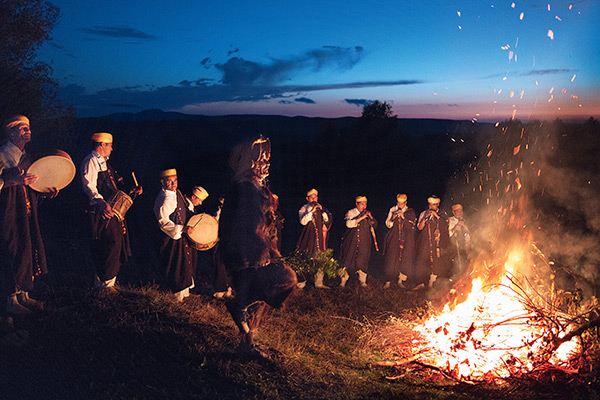
A frenzied performance by Bou Jeloud, the central figure of the annual Jajouka fertility rite, who dances with the musicians before jumping into the crowd brandishing olive branches
By the second night, Hassan and I are friends, perhaps because of the 200 dirham (about $20) I have dropped in the metal percussion tin; being a bountiful patron here can come cheap. He tells me, via a French-speaking musician, that he has been playing in the square for over 20 years, that he learned from his family, who came from Agadir in southwest Morocco. He tells me enough to remind that this music is fluid, a river that spreads out from and to many tributaries.
I wish I could stay for more questions and more music; in particular, a religious-derived strand of Gnawa music that promotes trances or visions in its audiences, often heard only in private houses. You can stay here for weeks and never hear this music, but I have the opportunity in the mountain village of Jajouka, where Rolling Stones founder Brian Jones and Brion Gysin once travelled, to hear what William Burroughs once described as a “5,000-year- old rock’n’roll band.”
Jajouka is a bumpy, half-hour ride up the mountain from the bustling town of Ksar el Kebir, site of the Battle of the Three Kings against the Portuguese in 1578. Although the story is shrouded in mystery, it’s said that the Master Musicians of Jajouka first emerged from the retinue of the battle’s victor, Ahmad I
al-Mansur. Village lore says the first musicians came from Persia; rather as in Marrakech, the first Gnawa musicians are thought to have come from the Sudan. Just as in the emerging USA, the music moves with the people.
The road winds up the Ahl Srif mountains, through beautifully sparse countryside, punctuated by craggy rocks, sheep, occasional locals calling for a ride, and omnipresent olive trees. Elsewhere in the Rif mountains, hashish is reportedly a major cash crop, hence the area’s traditionally intimidating reputation. But the village I finally reach is a peaceful, tiny farming community—one-storey, white stucco houses with corrugated iron roofs, tobacco-coloured chickens pecking in the back yards, donkeys and sheep grazing casually in tiny fields, and everywhere the olive trees that provide the major income stream. It’s here that the madness of the city stops; for the next three full days I can simply absorb the sights, sounds and smells.

The band includes seven or eight members playing the oboe-like rhaita.
Each morning, I breakfast on olive and spiral Moroccan pancakes, in a spartan, courtyarded house where Brian Jones stayed when he made a pilgrimage here to record the Master Musicians. In the afternoon, we lie on red, multipatterned Moroccan carpets while listening to gentle acoustic sounds, such as the Laitha, a traditional call to the music, which prepare us for the main event, the massed music of the pipers and drummers. The tiny village is based around a hallowed, ancient site, notably a sarcophagus holding the relics of a saint, Sidi Ahmed Sheikh, who had the power to heal the mad and the sick. The mosque is stark and elegant, reminiscent of an early Christian basilica. The annual Jajouka festival, a fertility rite which closely echoes the Roman ceremony of Lupercalia, shows that Islam, like Christianity, has incorporated ancient customs. The rite’s main character is Bou Jeloud, a wild figure said to live in a nearby mountain, his role played by a villager sewn into a goatskin, reputedly a manifestation of the god Pan.
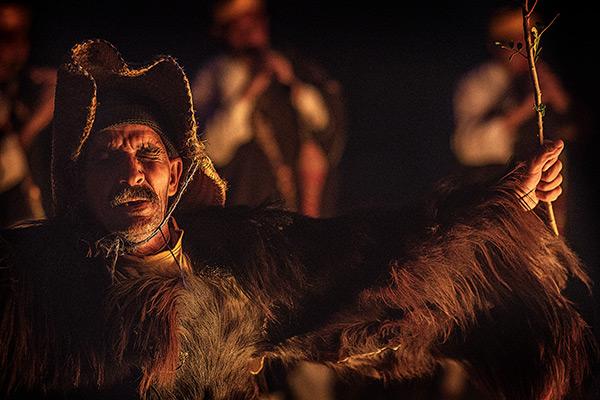
A frenzied performance by Bou Jeloud, the central figure of the annual Jajouka fertility rite, who dances with the musicians before jumping into the crowd brandishing olive branches
As the evening shadows lengthen, massed musicians walk into the tent, in formal, almost military robes, tending to each other gently, checking a turban or helping adjust a drum’s tension. Then the music starts: from the very first beat it’s arresting, melodies carried by seven or eight oboe-like rhaita—the pipes of Pan—flanked by five or six drummers, playing two types of drums, the Zyeki and the
larger Boomboo.
The pipers play in a call and response pattern; over the next five or six hours I hear hundreds of melodies, some surely blues or folk, some impossibly alien. Meanwhile the drums boom out polyrhythms, a deep simple beat from the bottom skins, and a machine-gun ratatatat from the top skins. The volume is overwhelming—the vibrations make your ears ring, your brain shake, your teeth rattle. It’s scarily strange, yet the way each song starts quiet, reaches a peak, then backs off in readiness
for the next climax, is familiar from many
Mississippi juke joints.
I’ve lost all consciousness of time, when suddenly a new energy fills the air as a tiny local man leaps on stage as the goatskinned Bou Jeloud, and suddenly the pipes seem to distort, in a rush of noise and feedback, like a Jimi Hendrix guitar solo. The man takes on a truly puckish air, leaping and dancing, shaking his hips in front of the musicians, who sweat with the intensity of their work. Bou Jeloud taunts both the musicians and the crowd, before leaping amongst them, brandishing olive branches with which he swipes young women and occasional unwary men.
It’s a startlingly provocative performance. Even today, witnesses claim that many young women, lashed by Bou Jeloud’s branches, have since fallen pregnant. The festivities run across three nights, with each successive performance finishing later and later, the sounds of pipes and drums resonating miles into the distance, as Pan dances in front of a bonfire, with sparks shooting up towards the black sky and the Milky Way twinkling overhead. In the days that follow, I think often about this performance; it reminds me of how the first American blues emerged in secret, of how drums and massed performances were banned, for fear they would instigate rebellion. It reminds me of the picnics bluesmen told me their grandparents held, where pipe and drums were audible for miles around. And of how their great-grandparents came from somewhere else. Places like Marrakech and Jajouka. It’s heartening to know that even in Jajouka and Marrakech, the music comes from somewhere else, from the Sudan, from Persia, from Rome. It belongs to no single location. It belongs to all of us.
Previous Article
Next Article
- AM WORLD
- FEATURES
